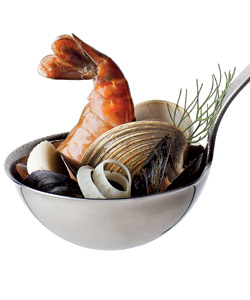 If classic French cuisine is the equivalent of a high-end portrait—exacting, refined, aristocratic—then bouillabaisse would be a Jean-Michel Basquiat. The legendary seafood stew may come from Marseille, but it belongs to the common man now, in a larger world where it’s subject to fewer rules and requirements. In other words, I thought I could make it in my small apartment kitchen on the Northwest Side.
If classic French cuisine is the equivalent of a high-end portrait—exacting, refined, aristocratic—then bouillabaisse would be a Jean-Michel Basquiat. The legendary seafood stew may come from Marseille, but it belongs to the common man now, in a larger world where it’s subject to fewer rules and requirements. In other words, I thought I could make it in my small apartment kitchen on the Northwest Side.
My first exposure to bouillabaisse was through Julia Child. I saw her on an old French Chef episode in glorious black and white, decapitating monkfish with a gargantuan cleaver, dismantling eel, and slicing through halibut. The butchery was sublime. I marveled at the heaps of stewed shellfish, steaming seafood, crusty bread, and glistening broth, and I knew that someday our paths would cross, bouillabaisse’s and mine.
Related:
RECIPE »
Bastard Bouillabaisse of a Half-Dozen Fathers
Before diving headfirst into my soup pot, I consulted a few chefs, who all described the same basics: A strong, rich, fishy broth. Firm whitefish. Shellfish. Some sort of bread to soak up the stock, traditionally finished with a garlicky, peppery mayo called a rouille. Beyond that, you’d find more consensus in the French Parlement. “Bouillabaisse is similar to chili in this country, where everybody has their own recipe,” says Tim Kirker, chef of Bistro Zinc. Some recipes demand monkfish, skate, or tiny smelts; most call for mussels and clams; others, shrimp and prawns. As for vegetables, should there be fennel? (Yes.) Saffron is a given, but what about leeks? (Yes.) Onion? How much tomato? Wherefore the potato? The standard was standardless.
Kirker says the key is a solid stock made with real fish bones; he peps up his halibut-mussels-clams bouillabaisse with a spicy rouille driven by pimente d’esplette, a Basque chili pepper. Giuseppe Tentori of GT Fish & Oyster roasts fennel, slices it into small pieces, and grills it. “I know it’s a pain in the ass,” Tentori says. “But they get a little smoky flavor.” He was almost apologetic when I told him I was going to give it a go myself, but left me with one hint about finishing the broth: “Try to smash the fish head inside the bowl, so you get all the flavor out.”
I put all the chef advice to work. From La Sardine’s Sotero Gallegos, I used thyme and a bay leaf and chose white wine over Pernod. Giuseppe Scurato of Ceres’ Table parks a nice large fillet of bass in the center of the dish; so did I. Le Bouchon’s Jean-Claude Poilevey told me to sauté my fish bones for the stock. For Kirker, I put a nice punch of cayenne in my rouille. And to round out my stock, I added a healthy knob of tomato paste in deference to the original recipe I found from Child.
This was to be the bastard bouillabaisse of half a dozen parents. I chopped leeks and onions. I shelled shrimp and demolished a couple of poor tilapias (no snapper at the store). I simmered fish heads for hours, and forgot to sauté my fennel. My rouille was ridiculously hot with raw garlic, and though the consistency should have been mayo-like, all I could accomplish was runny goo. The tilapia eyes gave me a reproachful look as I dropped them into the broth to simmer for an evening, but I crushed everything along the sides of my kettle, leaving no trace of anything that could cause me guilt. My mussels popped too quick; my clams, too slow.
After hours of slicing, decapitating, sautéing, simmering, skimming, and poaching, I had produced a fragrant, rich, deeply fishy bowl of sea bass, clams, mussels, and hearty broth. It was underseasoned and slightly oily, the clams were overcooked, and I forgot the damn shrimp. It was, in the middle of winter on the Northwest Side of Chicago, a rousing success.


